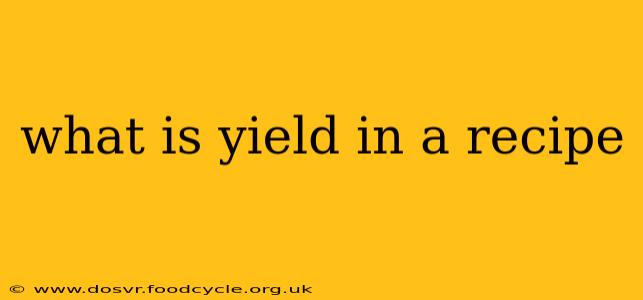Yield, in the context of a recipe, refers to the amount or quantity of the finished dish the recipe produces. It's essentially the answer to the question: "How much food will this recipe make?" Understanding yield is crucial for successful cooking and baking, allowing you to adjust ingredient quantities to serve more or fewer people.
Yield is typically expressed in several ways:
- Number of servings: This is the most common method, stating how many individual portions the recipe will create (e.g., "Yields 6 servings").
- Weight or volume: Recipes might specify the yield in terms of weight (e.g., "Yields 2 pounds of bread") or volume (e.g., "Yields 1 quart of soup"). This is particularly useful for recipes that aren't easily divided into individual servings.
Why is knowing the yield important?
- Scaling recipes: If you need to make more or less food, knowing the yield allows you to proportionally increase or decrease the ingredient quantities. For example, if a recipe yields 6 servings and you want 12, you'll double all the ingredients.
- Planning meals: Understanding how much food a recipe produces helps with meal planning and grocery shopping. You can accurately estimate how much food you'll have and avoid waste.
- Portion control: Knowing the yield helps you determine appropriate portion sizes for serving.
Frequently Asked Questions about Recipe Yield
Here are some common questions people have about yield in recipes, answered to provide a comprehensive understanding:
How do I calculate yield if it's not stated in the recipe?
If a recipe doesn't specify the yield, you'll need to make an educated guess based on the ingredients and the type of dish. For example, a recipe with a pound of ground meat might yield about 4 servings of burgers. Experience and familiarity with various recipes will improve your ability to estimate yield.
What if I want to change the yield of a recipe? How do I adjust the ingredients?
Adjusting the yield requires proportionally changing all ingredient quantities. The easiest way to do this is to determine the ratio of your desired yield to the original yield. For instance, if a recipe yields 4 servings and you want 8, you would double (multiply by 2) all ingredients. If you want 6 servings, you'll multiply all ingredients by 1.5.
Does yield always mean the number of servings?
No, while the number of servings is the most common expression of yield, it can also be expressed in weight or volume, particularly for recipes resulting in a large quantity of a single item like a loaf of bread or a batch of cookies.
How does yield impact cooking time?
Increasing the yield typically increases cooking time. Doubling a recipe usually doesn't simply double the cooking time, though. Factors like oven space and even heat distribution may require adjustments to cooking times. It's always best to monitor your dish closely when adjusting yields.
By understanding the concept of yield and how to adjust recipes to meet your needs, you'll become a more confident and successful cook or baker. Remember to always pay close attention to the details in your recipes and don't hesitate to experiment once you've mastered the basics!
